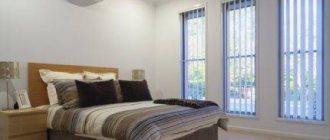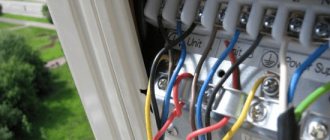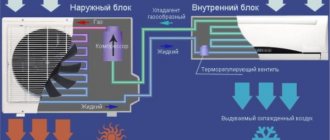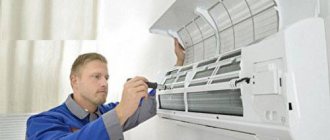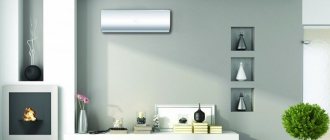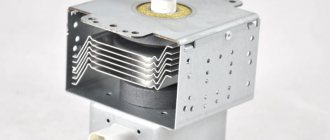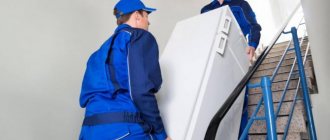Here you will learn:
- Some myths about air conditioners
- Available operating modes
- What are the consequences of turning on the air conditioner for heating in winter?
- Optimal operating conditions
- Using winter kits for air conditioners
- Features of starting heating in winter
- Models of winter air conditioners
Household air conditioners provide undoubted benefits in the summer, giving comfort and coolness to the apartment. The refrigerant pumped into them takes heat from the premises, which is sent outside and released into the atmosphere through the outdoor unit. Some models can work not only for cooling, but also as heaters. Is it possible to turn on the air conditioner in the apartment in winter for heating? This question is asked by many people who are encountering climate control equipment for the first time. Let's try to give a detailed answer to it.
Some myths about air conditioners
The first air conditioners, for example, Soviet BK and many other window models, were able to work exclusively for cooling. They hummed like transformer boxes, but supplied the apartments with life-saving coolness. Over time, traditional air conditioners were replaced by split systems consisting of two blocks. They are more convenient to install and have a lower noise level. In addition, they learned to work in two directions.
This is precisely what is associated with the myth that the air conditioner cools in the summer and heats in the winter. This is not true - without proper retrofitting (if it is provided at all by the manufacturer), it will not be able to work in the winter season. Heating is possible only in spring and autumn, when the outside air temperature has not yet dropped below zero. As soon as it crosses the zero mark, it cannot be turned on (or not recommended - it all depends on the model).
Another myth is that a split system takes in outside air, cools it and supplies it to the room. This is not true - the vast majority of air conditioners circulate the air in the rooms. The option to suck in outside air is present only in expensive models. Moreover, it is not very clear why such simple functionality has such an impact on the cost of equipment - it simply soars in price.
The difference between the operation of an inverter air conditioner
What is an inverter air conditioner and how does it differ from a simple one? The traditional device works according to a simple scheme: it heats the air to a certain temperature and immediately turns off the compressor. The so-called ON-OFF system.
That is, the compressor either works or doesn’t work at certain periods of time. But in inverter models it is possible not to completely turn off the compressor, but to reduce its rated power.
Why does this happen? Due to double conversion of electric current.
Initially, the standard alternating voltage from a 220V outlet is converted to direct voltage. And only then, with the help of an inverter, the direct current is again converted into alternating current, but not with the usual frequency of 50 Hz, but with an arbitrary one.
By adjusting and changing this very frequency, you can regulate the speed of the compressor rotor, and therefore change the power during operation.
You may ask, why all these troubles with frequency and power, and what exactly do they give? And they provide several advantages:
- absence of large starting currents when turned on
- less equipment wear
- but most importantly, a lower permissible operating temperature
That is, inverter models are able to start and operate at outside temperatures of -15C and below (-25C and even -30C). The oil in the system does not stagnate, but circulates constantly.
Most inexpensive household inverters certainly do not reach such low temperatures and operate normally between -5C and -7C.
If you installed such a household model at home, and the frost outside hit -25C, is it possible to turn it on or not? There are several options here.
Firstly, it may simply not start and go into defense. But if it does start working, its efficiency will drop significantly, as will the temperature in your house.
If such a low temperature remains for several days in a row, the oil in the device will thicken.
In this case, it is not recommended to turn off the air conditioner, otherwise a subsequent cold start will kill its compressor.
During operation, for better heating of the room, all inverter models must be able to direct the air flow vertically downwards. In this case, the room will warm up much faster. There is no particular point in heating the ceiling with warm air.
Because of this feature, some advise placing the indoor unit as low as possible, at a level of 0.5 m from the floor. True, in summer such cold for the feet will be very unpleasant.
Available operating modes
Climate control equipment specialists advise against turning on household air conditioners for heating in winter at ambient temperatures below +5 degrees.
An air conditioner with a heating function (we do not take as an example the most advanced models with an extended operating temperature range) installed in an apartment can be turned on only in two cases:
- In summer, in any heat, even the strongest.
- In autumn or spring - at temperatures not below zero (sometimes down to -5).
That is, in most cases, heating with an air conditioner in winter is impossible - it will simply break down. You can turn it on for heating in the winter season only in the southernmost regions, where temperatures rarely drop below zero (winters in the south are usually warm).
It’s easy to turn on the air conditioner for heating - pick up the remote control and use the Mode button to select the Heat mode, set the required temperature value. The device will “think” a little, after which it will turn on and begin to pump heat into the apartment. The sound of its operation changes a little, but there is nothing wrong with that - everything is within normal limits.
At first, the device may emit an unpleasant odor, which will disappear 10-15 minutes after switching on.
Choosing an air conditioner with heating function
Regardless of the preferred design of the device, when choosing an air conditioner for heating, you must pay attention to the following characteristics:
- rated power consumption;
- heat performance;
- energy efficiency class;
- heat operating temperature range;
- the presence of an automatic defrost function for the external unit.
There are several other factors that influence the choice of air conditioner for heating:
- room area and ceiling height;
- intended use of the premises.
It is better to give preference to premium inverter split models with a built-in winter kit and a larger heat exchanger, as they are characterized by reduced electricity consumption, increased heat production capacity and a favorable efficiency ratio.
What are the consequences of turning on the air conditioner for heating in winter?
If you turn on the air conditioner for heating in winter, at negative temperatures, then nothing good will happen - that’s for sure. Here is a list of possible breakdowns:
It is impossible to turn on the air conditioner in winter for cooling at sub-zero temperatures. The reason is simple - the oil in the compressor will freeze.
- The compressor will break down due to simple freezing of the oil, which becomes thick and prevents the heart of the unit from working.
- Malfunction of the outdoor unit due to condensate freezing - it simply has nowhere to go.
- Damage to refrigerant lines.
Here are three main reasons why you should not turn on your air conditioner in winter when the temperature is below zero. And the personal experience of many users suggests that already near the zero mark, heating efficiency is quickly lost. Sub-zero temperatures will completely destroy the unit - this is no longer a warranty case.
Parts for working in winter
A set of parts for heating a room in winter consists of the following:
- additional parts that reduce the number of fan rotations - this prevents the formation of ice on its propeller;
- another block for heat - it increases the heating temperature of the oil in freon, the duration of activation increases, and the chances of breakdown decrease;
- heating of the drain - condensate does not turn into a solid state, and this does not affect its progress and the drainage part.
It is necessary to install the set of parts only on a device in which 1 mode is “cooling”.
Optimal operating conditions
The air conditioner can be turned on for heating at temperatures above 0 degrees, and preferably above +5 degrees (in winter, spring and autumn) - this is the verdict of experts. It’s best to look at the instructions for a specific device, where the operating range will be indicated. There are models that can operate in an extended range - for example, up to -5 degrees. It is prohibited to use them in frost below this mark.
Some models can be used at fairly low temperatures, but they are rarely found on sale and are more expensive. They work in temperatures as low as -25 degrees, which is important for regions with cold winters.
Feasibility of the process
Air conditioners with heating function are structurally different from their older counterparts. The devices are equipped with a heat pump, making them very economical: one kilowatt of electricity spent on the air conditioner produces 2.5 to 4.2 kW of heat at the output. The devices are capable of efficiently heating a room at outside temperatures from 0 to -15 degrees, but more powerful units can easily cope with frosts of 30 degrees. For comparison: an oil heater, consuming the same kilowatt of electricity, is capable of delivering only 0.95 kilowatts of heat.
It follows from this that heating costs using an air conditioner are spent two times less than heating a house with a heater. However, it is advisable to choose an air conditioner as a heat source only in non-gasified regions, or in places where expensive liquefied propane is used instead of natural gas. In other cases, heating with air conditioning is certainly more expensive than heating with natural gas, and preference should be given to the latter.
Using winter kits for air conditioners
To begin with, let's remember one rule - you cannot turn on the split system for heating in the winter. This applies to the vast majority of household models. Their maximum is -5 on the thermometer. And at best it is zero or +5. The operating principle of the air conditioner is to blame for everything - when working for heating, its outdoor unit is cooled, and in winter it completely freezes. Therefore, it is impossible to use it for heating in severe winter frosts.
Some may object - they say that there are so-called winter kits on sale that allow you to turn on the air conditioning even in winter. Let's not deny that they really exist. They are only designed for air conditioning, not heating. That is, a winter kit is equipment designed to start the air conditioner for cooling in winter.
Winter kits include electronic control units that monitor freon pressure and ambient temperature, creating conditions for the successful launch of split systems in cooling mode in winter.
Winter kits solve the following problems:
- Heat up the crankcase with oil.
- Limit the fan rotation speed.
- Ensure drainage works.
Main purpose of the device
The main function of an air conditioner is to cool the room temperature during the hot season, which is why many people go to a hardware store before the start of the summer season. Split systems are equipped with copper cooling pipes that use freon. The indoor module has a heat exchanger through which it evaporates and releases cold air into the room. Near him there is a propeller that drives him back and forth.
Then the heated freon enters the outdoor unit and begins to transform inside it, i.e., it gives off heat and begins to evaporate again and produce cold, which is why almost all split systems have 1 mode - “cooling”.
Features of starting heating in winter
Let's assume that you have an air conditioner at your disposal that can be turned on in winter, when the outside air temperature is within the operating range of the device. You press the start button, select operating and temperature modes, but nothing happens - the air conditioner does not work for heating.
In this case, there is no need to rush - the system must warm up. She can be in “thought” for up to 15-20 minutes. The compressor does not work at this time, the fan does not work. After warming up, a click will be heard, the system will start in reverse mode, the radiator in the indoor unit will begin to gradually heat up. Heating works a little slower than cooling; the apartment will become warmer in 15-20 minutes.
Before turning on the air conditioner for heating, do not forget to vacuum the radiators and remove dust from the dust filters - this will help get rid of the unpleasant odor. By the way, a mobile air conditioner with heating works the same as a regular split system.
What is the difference between heating and heating with a split system?
Heating and heating are similar concepts, but there is a difference:
Air conditioning heating
- this is one of the functions of almost any model, which allows you to heat or preheat a room down to -10/-15 degrees.
Heating by air conditioner
- this is the use of a split system as a full-fledged source of thermal energy, the only one or complementary to another system with the ability to operate down to -25/-30 degrees.
Working with heat is a normal, familiar mode for modern models. But the efficiency of converting electrical energy into heat in conventional systems decreases sharply after zero degrees.
“Heat pumps” are the same air conditioners, but with special automation and compressors, as well as factory modification of the external unit, which allows, for example, to heat a house with an air conditioner and do it effectively even in severe frosts, when conventional split systems will not even start . Northern Europe has been heated by air-to-air and air-to-water heat pumps for 40 years.
Models of winter air conditioners
If you want to use an air conditioner to heat your apartment, let's look at models that can be turned on even in winter. We will focus on samples with an operating temperature range of up to -25 degrees.
Mitsubishi Electric MSZ-FH35VE / MUZ-FH35VEHZ
The estimated cost of this air conditioner is 110 thousand rubles. It is an inverter-type wall-mounted split system with an air flow capacity of up to 13.2 cubic meters. m/min. It can be turned on for heating at temperatures down to -25 degrees, and for cooling at temperatures down to -10 degrees. Model features:
- Built-in air filtration.
- Accurate temperature control.
- Low noise level.
- Self-diagnosis system.
- The distance between blocks is up to 20 meters.
The heating power is 4 kW with a power consumption of 800 W (no violations of the laws of physics - this is not efficiency, but just the result of the operation of a thermodynamic machine).
GENERAL ASHG09LMCA
If you want to get an air conditioner that can provide heating in temperatures down to -25 degrees, but you are not ready to pay more than 100 thousand rubles for it, then we have a solution. This is a compact split system from GENERAL with a thermal power of 2990 W. Air flow – up to 10 cubic meters. m/hour, with the ability to adjust the fan speed. It can be included in the smart home control circuit or controlled from the remote control. The ambient temperature during heating operation is up to -25 degrees. Among all similar air conditioners, this model is the most affordable.
Fujitsu ASYG12LMCB / AOYG12LMCBN
Another inverter type split system. It can be turned on for heating in frosts down to -25 degrees. The cost of the model is about 85 thousand rubles. Thermal power – 4 kW, air flow – up to 12.25 cubic meters. m/min. The air conditioner is equipped with an anion generator and an air filter. It is distinguished by its compact design and low power consumption - 970 W in heating mode.
Kentatsu KSGM61HFAN1 / KSRM61HFAN1
Before us is a completely extreme air conditioner. It can be turned on in heating mode even in the bitterest frosts - down to -40 degrees. In the same frosts, the cooling function also works. Thermal power is 6740 W with a power consumption of 2.1 kW. A powerful fan ensures the passage of up to 19.2 cubic meters of air per hour. There is also a dehumidification function and a built-in air filter. The model is intended for use in commercial premises, operating in heating and air conditioning modes.
Efficiency and thermal efficiency of air conditioners
Air conditioner efficiency refers to an assessment of the efficiency of the system. This value is calculated from the ratio of consumed and useful power. In this case, useful power is the amount of heat supplied per unit time. We can talk about effective operation when the efficiency of the air conditioner in heating mode is more than 1.
Usually, at positive temperatures outside, the amount of heat generated exceeds the amount of energy consumed by 2-4 times. If the power consumption is 1 kW, then the heating power will be approximately 2-4 kW. The manufacturer indicates the rated power consumption, which may slightly differ from the actual values.
The energy efficiency coefficient of an air conditioner is usually labeled as COP (Coefficient of Performance). It can be calculated by correlating two values - heating power to consumption power.
If the thermal power was 3.5 kW and the consumption was 1.2 kW, then the efficiency would be approximately 2.9 kW. This is considered quite high performance. If the temperature outside decreases, energy consumption increases accordingly, and the coefficient drops noticeably. A ratio of less than 2.4 is considered low. Devices with such values are marked below A-class.
Advantages and disadvantages
Many people do not know which device will be more effective. The operation of the unit in winter consists of the presence of special parts that are not present in summer models. For example, if you use strong air pressure to convert it into heat, the mechanism will be subject to severe stress and may eventually break. The amount of electricity used can also increase greatly, so it is better to immediately purchase a device model with 2 modes. Such models have many advantages in use:
- Automatic control and preservation of the set temperature in the apartment, as well as switching it to any of 2 directions.
- Low amount of electricity consumed.
- The equipment cannot harm the residents of the house in any way.
- Low combustion of air in the apartment. The emission of carbon monoxide is minimized, in contrast to TEN (tubular electric heater) models.
- Good efficiency.
In addition to its good qualities, the split system also has negative sides. These qualities do not allow them to completely bypass classic electric heaters:
- high cost of air conditioners;
- complex mechanism;
- if a breakdown occurs, it will be difficult and expensive to fix it;
- sudden changes in temperature can break the device;
- To prevent the lubricant from deteriorating, you need to turn on the device from time to time.
Warmth in English in the air conditioner
Before setting the air conditioner to heating mode, you need to make sure that its operating temperature is within operating limits, otherwise the system may fail.
- Undoubtedly, different manufacturing companies (for example, LG, Samsung or General) produce largely different models, but there is still a certain universal model for turning on the heating:
- It is necessary to turn on the device (the power button is labeled “On”).
- Next, press the “Heat” key, which means “warmth”.
If this button is not present, other options may be present: “Mode”, or any other buttons with icons such as “sun”, “drop”, “fan”, “snow” drawn under/above them. If none of these buttons are present, this means that the system is not capable of heating.
If there is a “Mode” button, you need to press it several times until the “sun” or the signature “Heat” is displayed. Using the switching arrows or “+/-” buttons, you need to set a comfortable temperature.
After completing this entire procedure, the fan will turn on, and after five (maximum ten) minutes warm air will be generated, heated to the temperature previously set by the user. Some remote control models may be configured differently - it is recommended to read the instructions before setting up.
To turn on the air conditioner in heating mode, it is not always necessary to use the remote control. Any split system has an external panel (sometimes hidden by a protective screen), the buttons of which duplicate the remote control keys.
This is for situations where the remote control is lost, broken, or located far away. Using the panel, you can set the system to heating mode in the same way.
How to set the heating mode
- Before turning on the air conditioner to heat, make sure that:
- The air conditioner has a heating function;
- The outside air temperature corresponds to the stated values in the instructions for the air conditioner.
Each instruction manual for the air conditioner indicates at what temperatures it is allowed to operate. If you are unsure, call the company that installed or serviced your air conditioner.
A conventional split system can be operated down to -5 degrees, but we advise our clients to operate it down to 0 degrees. By installing the winter kit, you can use the air conditioner in heating mode and turn it on even at -30 degrees.
Some models of air conditioners - inverter air conditioners - can heat a room even in winter at fairly low sub-zero temperatures.
When the heating mode is turned on, the fan may run for 3-5 minutes at the beginning to prevent cold air from blowing in while the air conditioner warms up.
Since the air conditioner heats the room by extracting heat energy from the outside air, its heating capacity may decrease if the outside temperature is extremely low.
In Heat mode, the air conditioner will heat the room. You can set the temperature and fan speed to feel the heating device work in the cold season.
- To set the heating mode, perform the following steps:
- Press the power button to turn on the air conditioner.
- Press the mode button to set the operating mode.
- Each time you press the Mode button, the mode changes in the following order: Auto → Cool → Dry → Fan → Heat.
The fifth function is the heating mode.
During Auto mode, the air conditioner controls its operation itself. He will choose the mode himself and provide the most comfortable environment.
- After selecting Heat mode, set the desired temperature using the button on the remote control.
- If necessary, set the fan speed using the button on the remote control.
When setting the heating mode, please consider the operating temperature range shown in the tables below.
For inverter air conditioners (AQV** series):
For non-inverter (“conventional”) air conditioners:
When operating the air conditioner in winter at temperatures below those specified by the manufacturer, icing of the heat exchanger, compressor and fan blades may occur, which will lead to failure of the air conditioner.
How to run all functions
Switching from cooling mode to heating mode is carried out using the remote control. There are several options to do this:
- Option #1.
- There is a "MODE" button on your remote control.
- When you press it, the “sun” icon or the words “HEAT” will appear on the remote control display.
- You need to wait a little, about 5 minutes, since the warm air will not come out immediately.
- It is also possible to make all of the above settings on the remote control and then, pointing the remote control at the air conditioner, press the “ON” button.
- Option #2.
- If there is no “MODE” button on the remote control, but there is a button above which there are symbols: “snowflake”, “fan”, “droplet”, “sun”.
- We choose “sun”.
- It is also necessary to wait a little, since warm air will not come out immediately.
Remote control
Each of us knows that this device comes with a remote control. Setting up the air conditioner using the remote control is quite simple. The instructions describe in detail all the actions that can be performed with the air conditioner using the remote control.
You can easily set it up so as not to catch a cold. Using the remote control you can set exactly the temperature that is required. You can easily make the air warmer or colder. The main thing is that you can do this without leaving your couch or office desk.
Typically, heat and cold are indicated by some icons on the remote control. For example, heat is indicated by the sun, and cold by a snowflake. And the sign “more than” or “less than” is indicated by the corresponding arrows. The buttons are quite convenient.
The dimensions of the control panel themselves are small. And also it is very light. Holding the remote control in your hand is very comfortable and easy. You can even put it in the pocket of your robe or jacket, it won't get in your way.
The only problem can be that such a small and light thing is not at all difficult to lose. Therefore, the remote control should be kept in sight and should not be allowed near children.
But what to do if suddenly the remote control is not at hand?
- Here is a list of necessary actions when you need to turn on the air conditioner without a remote control:
- First you need to make sure that the air conditioner is working. Check the wiring to it. If it is in place and the wires are not broken or cut, then you can follow the following instructions.
- Find the plastic cover on the front of this household item. It is small in size and rectangular in shape. It is located mainly a little lower than the so-called air conditioner curtains.
- This cover must be carefully lifted (grasping it with your fingers on two opposite sides), pressing slightly on the cover itself.
- Under this cover there is a panel on which there should be a button. Where exactly it is located (left or right) depends on the model of the unit. But often it is highlighted.
- If the device is in working condition, this button will glow greenish (less often orange). Of course, under it there is a corresponding inscription in English “on and off”.
- This button should be pressed and held for some time (several seconds). The device must either work or turn off. This is to turn the unit on or off. If you need to change warm air to cold air, then you need to press the button without holding it down.
Please note that you will not be able to change the temperature using such a panel; for this you need a remote control. Therefore, you should not delay your search. If the remote control is broken, you just need to buy a new one. To do this, it is enough to know the make and model of the device.
If the air conditioner does not turn on for heating
If you have completed all the steps described above, but the air conditioner still does not turn on for heating, then a possible reason is that it simply does not have such a function. You can check this in the instructions for the air conditioner.
If the instructions say that such a function is still provided, then contact the service company that serves you; you may need repairs.
There are two main options: either the setup was done incorrectly, or there is a breakdown in the device itself. It is recommended to turn off the air conditioner and repeat all steps again. If after ten minutes there is no heat from the device, there is a breakdown.
The most common malfunction is a lack of freon, necessary for the functioning of the heating system. In this situation, it is necessary to take the air conditioner for repair, or call qualified specialists at home, especially if the device is under warranty.
In addition, it is possible that the air conditioner is turned on at temperatures incompatible with its normal operation. It should be noted that some manufacturing companies produce additional modifications that expand the operating temperature range from -30 to +30 degrees Celsius.
Heating with air conditioning in winter - personal experience
I bought a small two-story house of 120 sq.m. in the center of Crimea in a small gardening partnership. Essentially, it was just a box made of shell rock, without even a roof. I hired a team of local builders who did it completely for me, from the roof to the interior decoration.
Looking ahead, I’ll say that they were the ones who robbed me, but since I have no experience in this matter, I had to fork out the cash.
There is no gas in the village; in order to supply electricity to the house, I had to buy poles myself and pay for the connection. All this cost 6 thousand evergreen pieces of paper.
I decided that I would heat it with coal, for which I bought a whole LAWN of anthracite in bags and lowered it into the basement. There was also a small room set aside for the boiler room. The same builders supplied me with a boiler of unknown origin and installed radiators on both floors (which I later regretted).
First problems.
As it turned out, the builders practically did not insulate the house, and winters in my region are unpredictable. It happened that in mid-January it was +15, and sometimes it was -20. In general, I had to learn the profession of a fireman.
As it turned out, the boiler is low-power and cannot heat the required volume of water. Moreover, we had to add coal every 3-4 hours. Naturally, everything in the house cooled down overnight, and the unpleasant frost invigorated me in the morning.
At first I decided to buy a new boiler and heat accumulator, and called the normal craftsmen. They said that my heating system was not designed correctly and that I would not achieve anything with it. Given the size of my basement, it was necessary to install a heated floor on the first floor. I started to think further.
I decided not to philosophize and install air conditioners. I consulted with the craftsmen, they persuaded me to take a Panasonic inverter multi-split system for 24,000 BTU. That’s what they decided on - they installed one outdoor unit and three indoor ones.
They ruined my entire outer wall with pipes, but it was necessary. It was winter, mid-December, it was -5 degrees outside, there was snow.
As soon as the cable was installed and the air conditioner was connected, I immediately turned it on and began to enjoy the warmth. Panasonic inverter is a thing, I tell you! It heats like crazy, the outdoor and indoor units operate silently - even at night in complete silence you cannot hear them.
Impressions of heating with air conditioning in winter.
The advantage of heating with air conditioning in winter is that it quickly warms up the air. When I arrive in a cold house and turn on the unit on the first floor, it warms it up in five minutes.
The disadvantage of this method of heating a house is that the air is warm, but the furniture and generally everything in the house remains cold. And just imagine, you are warm, +24 in the house, but you sit on the sofa and feel how your butt is covered with frost. Not very comfortable.
Therefore, I decided to leave the air conditioner on the first floor turned on at +18 if I went somewhere for a short time. This way you can save a little, and when you return home, it’s not so unpleasant to fall into a chair.
Heating with air conditioning in severe frost.
This is not an advertising article, but I can say that Panasonic is not considered a cool air conditioner for nothing. When it was -15 outside, it heated the house perfectly. Of course, the electricity consumption was high, but this is not so important, because comfort and health are more expensive.
It is worth mentioning separately that the lower the temperature outside, the more electricity the air conditioner consumes. On the other hand, the better the house is heated, the less often it turns on (if there is a built-in temperature sensor).
Unfortunately, I can’t give exact data in kilowatt-hours, but I didn’t have to pay that much. In the coldest month, electricity costs ran up $150.
But it’s worth considering that I lived mainly on the first floor, and only spent the night on the second. It has almost never happened that all three indoor units were working at the same time.
For comparison, I will give an example. A friend has a house of 100 square meters, she lives a couple of kilometers from me. She heated all winter with convectors and the bills were twice as much!
Second season.
After the winter, I decided to spend money and insulate the house. As it turned out, they laid only 5 cm of cheap mineral wool on the external walls, and they also left gaps in the places where the profile for the cladding was located.
We redid the facade - laid 150 mm of basalt wool, filled all joints with foam, and insulated the floors. They also did a good job with the roof - there are craftsmen who blow it out with something like liquid foam through hoses. It is cheaper than removing the roof and installing it again.
I decided not to look for another heat source, but to use an air conditioner to heat the house. I was right - bills dropped by one and a half times (considering that there is a TV, computer, washing machine, etc.).
After insulation, the house retains heat well and does not cool down so quickly. I thought about installing three-chamber double-glazed windows, but they dissuaded me - the craftsmen said that two-chamber windows would be enough. Moreover, I don’t have many windows.
I summarize my personal experience of heating with air conditioning.
Heating with air conditioning is beneficial, but only if it is a good air conditioner. The presence of a temperature sensor and an inverter reduces energy costs and wear and tear on the air conditioner. If you are going to warm up in this way, leave the air conditioner on at least +18 so that it is comfortable to return home.
Be sure to insulate your house - this is very important! In a well-warmed and insulated home, you can turn off the air conditioning and safely leave for a day or two; the temperature will drop, but the building will not freeze.
It can get chilly at times in the fall and spring, but that's only for a few weeks in my area. Mostly the weather is warm, the sun warms up a well-insulated house quite well. In theory, heating with air conditioning in the off-season is more profitable than in winter - it’s not so cold outside and the efficiency of the air conditioner increases.
Using an air conditioner to heat your home is more expensive than heating it with coal or gas, but when there are no alternatives, you have to do it. You'll have to pay for electricity, but it's better than walking around the rooms in a down jacket.
Criterias of choice
The quality of heating the room will depend on the correct choice of air conditioner, which directly affects the comfort of the home. Before purchasing a system, its functional responsibilities should be clearly defined. If you plan to install hot water supply, you must opt for inverter units equipped with an additional hydraulic module. External air temperatures in winter have a decisive influence on the choice of air conditioner. And if in the southern regions of the country you can limit yourself to purchasing a traditional model, then in conditions of a sharply continental climate with night temperatures dropping to -30 degrees, you should buy a serious device equipped with a heat pump and a system for protecting against freezing of oil and condensate.
When choosing a device with a hydraulic unit, you should remember that if the device is installed outside, then it will have to be insulated for the winter. This especially applies to country houses in which accommodation during the winter period is carried out periodically or completely absent. When the hydraulic unit is located internally, the device can be connected to the “warm floor” system and radiators. Installing such equipment will certainly cost certain costs, but they will quickly pay for themselves during the life of the device.
How to choose the right model
How the heated air conditioner works will depend on the correct selection of the model.
Here it is important to pay attention to the characteristics of COP (heating to consumed power ratio) and EER (cooling/consumption ratio):
- COP in home models should be 2.8-4;
- for EER this figure can be 2.5-3.5 units.
Regardless of the recommendations, this type of equipment will need to be installed individually, taking into account the characteristics of the room. In this case, it will be important to calculate the possible heat losses that come from windows and doors. It is in these places that it would be reasonable to create a thermal curtain. A little about control: the equipment will be switched either from the remote control or manually. Heating can be set automatically.
Preparing equipment for cold weather
To protect the unit from severe frosts, it is necessary to prepare the system, since a short start of the device in severe frost can lead to breakdown. To use your air conditioner normally in summer, you need to do the following:
- completely pour the refrigerant into the external unit;
- put a canopy - protection from snow;
- Do not use the device too often in winter.
After winter, you should not rush to turn on the air conditioner without diagnostics. Experts insist on supplementing the pipes with freon and carrying out a complete cleaning.


